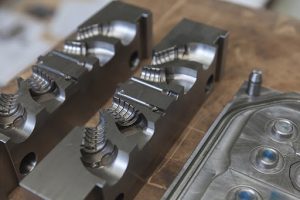While you probably know what the injection molding process means and brings to each manufacturing operation, what does it involve to optimize your injection molding process? In a big picture sense, it means thoroughly considering your injection molding process to develop the most value-driven, efficient operation possible.
It’s not that different from other aspects of the molding process where you’ve probably heard the word optimization before, like with product design, where each optimized design process takes the best, most relevant practices into account. Afterward, it considers the physical engineering aspect of the production process and, from there, pursues a better solution for designing the final product to reach maximum effectiveness and bottom-line efficiency.
In that same manner, it’s helpful to think of efficient injection molding process optimization as a specific procedure entirely driven by observation and data. This means that these data-driven and observational findings can possibly “fly in the face” of traditional wisdom and conventional ways of doing specific tasks, which is why process optimization is critically important. However, at the end of the day, if all sets of rules and guidance could be applied to all injection molding processes, and the processes would work as well as possible, optimization wouldn’t be necessary.
Unluckily, manufacturing processes don’t always work like that. Luckily, though, optimization is a well-researched and regarded practice. Now that we have a basic understanding of injection molding optimization let’s look at the four steps that could optimize your injection molding processes.
Mold Testing And Evaluation
Table of Contents
Exploring and reviewing the functionality of your injection mold as it works using your intended materials can yield significant advantages in your efforts to optimize your molding process. Particularly in plastic injection molding, the wide range of resin materials and plastic formulations available means that minor differences in melt temperature, viscosity, and more, can add up to growing variations and fluctuations in the molding process that could lead to inefficient operation, rejected parts, and unoptimized production run.
To avoid this, you should embrace the critical aspects of mold testing, including shot testing, fill rate and pattern, and pressure curve assessments.

Tool Testing And Modifications
As soon as you have a practicable size of information from your mold testing and evaluation, you’re only then able to do the fine-tuning that can lead to even more significant gains in the process of injection molding process optimization and efficiency.
For example, if you experienced varying fill times or short shot issues, you might want to talk to your engineers to tweak the design and layout of the tools to optimize them for these problems. Or, if the mold temperature was inconsistent or out of the acceptable range, your team might adjust it for more optimal heating and cooling times.
Quality Control Through Sample Creation
While quality control is undoubtedly a vital part of the overall injection molding production process, which commonly happens post-production, quality control for sample parts works a bit differently. Because in the pursuit of injection molding process optimization, sample parts can play a crucial role.
Firstly, they take the risk away from conducting testing and optimization through a full production run, where issues can be determined only after all the parts get manufactured in a single batch. Moreover, they permit manufacturers to understand better their process and how their machinery is operating upfront in a more controlled environment.
Secondly, by evaluating a sample production process of a minimal part run, manufacturers can get a firsthand look at how their entire process will go and assess part quality, shot size, melt temperature of the actual batch of resin they have their hands, and more.
The insights gained from sample runs and the whole round of quality control review can often offer much more than the time and money invested in them.
Process Parameter And Performance Ranges
Each part of the injection molding proceeding has acceptable performance ranges—from the tools to the material, machinery, etc. An unoptimized, inefficient injection molding process is every process that operates outside of these ranges or even at the outer bounds of them. You’ve read that right; even if the process components are technically working within their range, the process may still not be fully optimized if the manufacturer hasn’t done the testing and fine-tuning to check if improvements are possible.
In Conclusion
Experience in injection molding design and process is perhaps the most incredible tool known to humankind at your disposal to enjoy a fully optimized, efficient, and successful production experience. So, as you go through the steps above and utilize the tangible results of your testing to make incremental modifications in your injection molding process, keep testing until the results start to add up and you see a real impact on your process and finished products.







